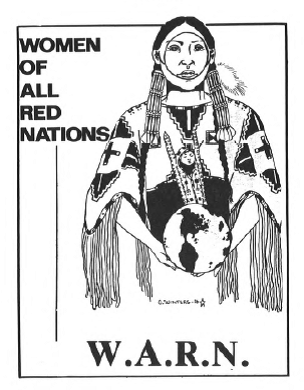Background
In 1974, activists Lorelei DeCora Means, Madonna Thunder Hawk, Phyllis Young, and Janet McCloud formed Women of All Red Nations (W.A.R.N.). Nearly 200 women from over 30 tribal communities participated in W.A.R.N.’s founding conference in Rapid City, South Dakota. The multi-generational group included veterans from the American Indian Movement (AIM), as well as first-time activists. W.A.R.N.’s leaders hoped to both rejuvenate a struggling movement and create new, previously unexplored opportunities for activism.
During the early 1970s, the FBI increasingly focused on stopping the actions of the American Indian Movement (AIM). By 1974, many AIM leaders were either imprisoned, dead, or hiding from government surveillance. W.A.R.N. aspired to fill the leadership vacuum and continue the movement’s progress.
At the same time, W.A.R.N. also hoped to formalize the role of women within the movement. Women had always been a strong force within AIM and other Red Power initiatives. It was time for that work to be officially recognized. In addition, W.A.R.N. wanted the opportunity to focus on issues that specifically addressed the needs of women. One of their primary concerns was the U.S. government’s deeply traumatic practice of forced sterilization of indigenous women. They also hoped to expand Native-led education initiatives, create opportunity for family stability, and support Indigenous political prisoners. Although W.A.R.N. spent a significant amount of time focusing on these so-called women’s issues, they also fought for the sovereignty of all indigenous peoples. In the 1980s, for example, they formed a coalition with white farmers to stop mining in the Dakotas.
W.A.R.N. provided an outlet for women who wanted to be agents of change. Beyond tackling these issues, they attended national and international conferences. W.A.R.N. members worked with women from diverse backgrounds, sharing their unique cultural perspective that revolved around Mother Earth and the sacredness of land.
About the Image
This image appeared on the cover of an informational booklet distributed by W.A.R.N. in 1977. The image is intended to provide the reader with a visual introduction to the organization. The 45-page booklet contains information about W.A.R.N. and its goals. Articles cover education, sterilization, family care, government-sanctioned genocide, and political prisoners.
Vocabulary
- American Indian Movement: An indigenous civil rights organization founded in 1968.
- political prisoner: Someone imprisoned because of their political or personal beliefs.
- Red Power: A civil rights movement that promoted the political and human rights of the indigenous peoples of North America.
- sovereignty: The ability of a group to govern itself.
- sterilization: Surgery to make a person unable to have children.
Discussion Questions
- What do you see in this image? Describe the various visual components.
- What can you learn about W.A.R.N. from this image? What was important to their members?
- Based on the information provided, why was W.A.R.N. formed, and what issues did it hope to address?
- What do you think made W.A.R.N. different from other women-led activist organizations in the 1970s?
Suggested Activities
- AP Government Connection: 3.10: Social movements and equal protection
- Invite students to explore the contents of the W.A.R.N. booklet, which is available in full here (scroll to page 20 of the PDF document). Encourage students to select one article or issue that interests them to learn more about the group’s stance and activities around that issue.
- Many of W.A.R.N.’s members participated in the occupation of Alcatraz. Connect this resource with the photographs from the occupation to expand the conversation around women and the Red Power movement.
- Review this resource in conjunction with the life story of early 20th century activist Zitkala-Sa. Encourage students to think about how these two resources connect to one another.
- Many of the leaders of W.A.R.N., including co-founder Madonna Thunder Hawk, attended government-run boarding schools. This traumatic experience had a profound impact on their lives and informed their commitment to preserving their community. Learn more about Indian boarding schools by pairing this resource with the letters between a mother and the Carlisle Indian School and the life story of Zitkala-Sa. Invite students to think about how the boarding school system might have informed the demands of W.A.R.N. mothers.
- Education was a major component of W.A.R.N.’s work. The members believed education was critical to the survival of their culture. Connect this resource to life stories of Zitkala-Sa and Mary Kawena Pukui to consider how education plays a critical role in Indigenous activism in the Native American and Native Hawaiian communities.
- Many civil rights organizations witnessed the rise of female leaders in the late 1960s and early 1970s. Compare this resource to the resource on the Young Lords and the interview with women of the Black Panther Party. Ask students to compare the organizations and reflect on how they approached the work in unique ways.
Themes
AMERICAN IDENTITY AND CITIZENSHIP; ACTIVISM AND SOCIAL CHANGE; GEOGRAPHY AND THE ENVIRONMENT







